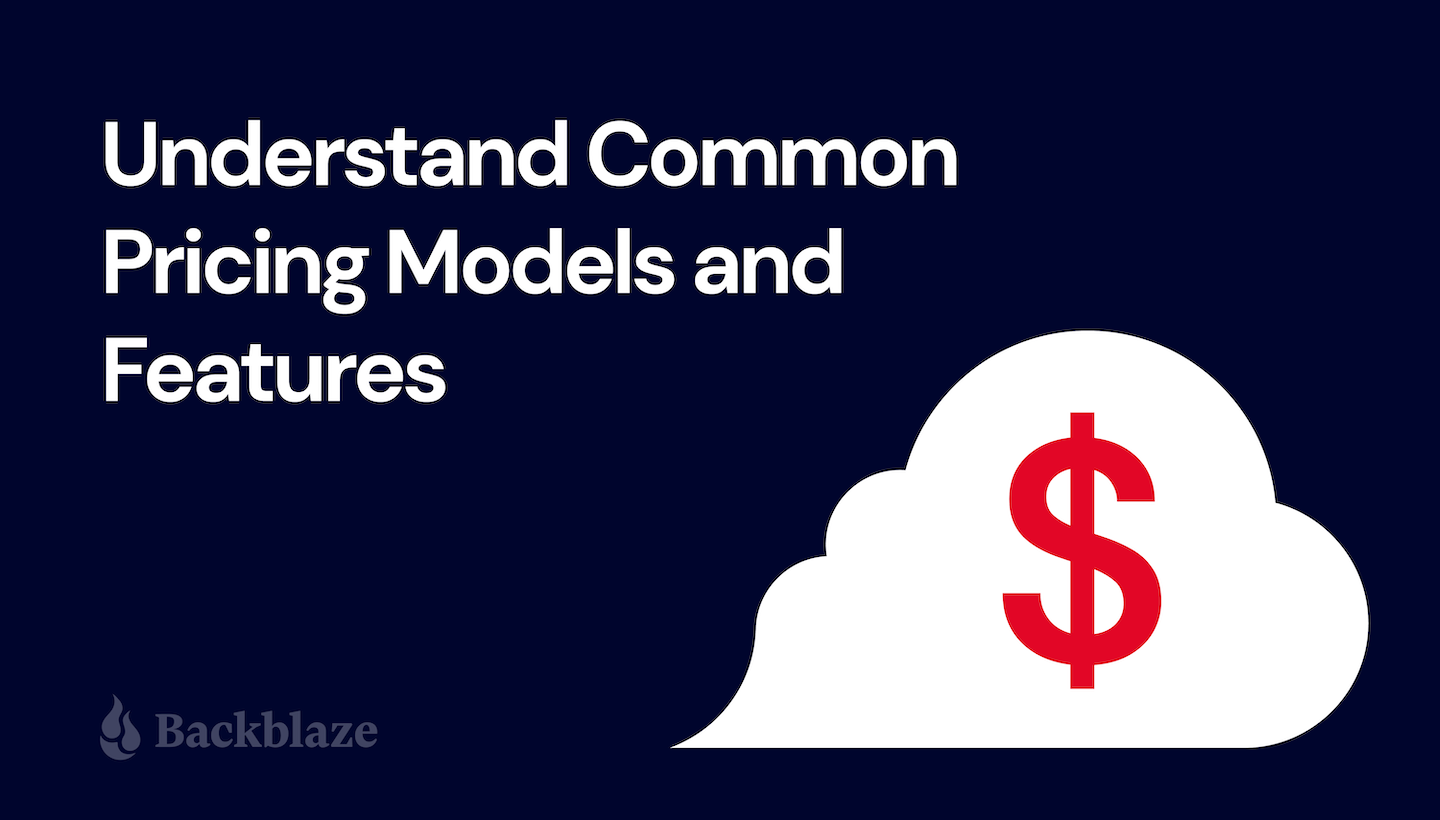
Between tech layoffs and recession fears, economic uncertainty is at a high. If you’re battening down the hatches for whatever comes next, you might be taking a closer look at your cloud spend. Even before the bear market, 59% of cloud decision makers named “optimizing existing use of cloud (cost savings)” as their top cloud initiative of 2022 according to the Flexera State of the Cloud report.
Cloud storage is one piece of your cloud infrastructure puzzle, but it’s one where some simple considerations can save you anywhere from 25% up to 80%. As such, understanding cloud storage pricing is critical when you are comparing different solutions. When you understand pricing, you can better decide which provider is right for your organization.
In this post, we won’t look at 1:1 comparisons of cloud storage pricing, but you can check out a cloud storage pricing calculator here. Instead, you will learn tips to help you make a good cloud storage decision for your organization.
Evaluating Cloud Storage Providers? Gather These Facts
Looking at the pricing options of different cloud providers only makes sense when you know your needs. Use the following considerations to clarify your storage needs to approach a cloud decision thoughtfully:
- How do you plan to use cloud storage?
- How much does cloud storage cost?
- What features are offered?
1. How Do You Plan to Use Cloud Storage?
Some popular use cases for cloud storage include:
- Backup and archive.
- Origin storage.
- Migrating away from LTO/tape.
- Managing a media workflow.
Backup and Archive
Maintaining data backups helps make your company more resilient. You can more easily recover from a disaster and keep serving customers. The cloud provides a reliable, off-site place to keep backups of your company workstations, servers, NAS devices, and Kubernetes environments.

Case Study: Famed Photographer Stores a Lifetime of Work
Photographer Steve McCurry, renowned for his 1984 photo of the “Afghan Girl” which has been on the cover of National Geographic several times, backed up his life’s work in the cloud when his team didn’t want to take chances with his irreplaceable archives.
Origin Storage
If you run a website, video streaming service, or online gaming community, you can use the cloud to serve as your origin store where you keep content to be served out to your users.

Case Study: Serving 1M+ Websites From Cloud Storage
Big Cartel hosts more than one million e-commerce websites. To increase resilience, the company recently started using a second cloud provider. By adopting a multi-cloud infrastructure, the business now has lower costs and less risk of failure.
Migrating Away From LTO/Tape
Managing a tape library can be time-consuming and comes with high CapEx spending. With inflation, replacing tapes costs more, shipping tapes off-site costs more, and physical storage space costs more. The cloud provides an affordable alternative to storing data on tape where you pass the decreased margins off to a cloud provider—they have to worry about provisioning enough physical storage devices and space while you pay as you go.
Managing Media Workflow
Your department or organization may need to work with large media files to create movies or digital videos. Cloud storage provides an alternative to provisioning huge on-premises servers to handle large files.

Case Study: Using the Cloud to Store Media
Hagerty Insurance stored a huge library of video assets on an aging server that couldn’t keep up. They implemented a hybrid cloud solution for cloud backup and sync, saving the team over 200 hours per year searching for files and waiting for their slow server to respond.
2. How Much Does Cloud Storage Cost?
Cloud storage costs are calculated in a variety of different ways. Before considering any specific vendors, knowing the most common options, variables, and fees is helpful, including:
- Flat or single-tier pricing vs. tiered pricing.
- Hot vs. cold storage.
- Storage location.
- Minimum retention periods.
- Egress fees.
Flat or Single-tier Pricing vs. Tiered Pricing
A flat or single-tier pricing approach charges the user based on the storage volume, and cost is typically expressed per gigabyte stored. There is only one tier, making budgeting and planning for cloud expenses simple.
On the other hand, some cloud storage services use a tiered storage pricing model. For example, a provider may have a small business pricing tier and an enterprise tier. Note that different pricing tiers may include different services and features. Today, your business might use an entry-level pricing tier but need to move to a higher-priced tier as you produce more data.
Hot vs. Cold Storage
Hot storage is helpful for data that needs to be accessible immediately (e.g., last month’s customer records). By contrast, cold storage is helpful for data that does not need to be accessed quickly (e.g., tax records from five years ago). For more insight on hot vs. cold storage, check out our post: “What’s the Diff: Hot and Cold Data Storage.” Generally speaking, cold storage is the cheapest, but that low price comes at the cost of speed. For data that needs to be accessed frequently or even for data where you’re not sure how often you need access, hot storage is better.
Storage Location
Some organizations need their cloud storage to be located in the same country or region due to regulations or just preference. But some storage vendors charge different prices to store data in different regions. Keeping data in a specific location may impact cloud storage prices.
Minimum Retention Periods
Most folks think of “retention” as a good thing, but some storage vendors enforce minimum retention periods that essentially impose penalties for deleting your data. Some vendors enforce minimum retention periods of 30, 60, or even 90 days. Deleting your data could cost you a lot, especially if you have a backup approach where you retire older backups before the retention period ends.
Egress Fees
Cloud companies charge egress fees when customers want to move their data out of the provider’s platform. These fees can be egregiously high, making it expensive for customers to use multi-cloud infrastructures and therefore locking customers into their services.
3. What Additional Features Are Offered?
While price is likely one of your biggest considerations, choosing a cloud storage provider solely based on price can lead to disappointment. There are specific cloud storage features that can make a big difference in your productivity, security, and convenience. Keep these features and capabilities in mind when comparing different cloud storage solutions.
Security Features
You may be placing highly sensitive data like financial records and customer service data in the cloud, so features like server-side encryption could be important. In addition, you might look for a provider that offers Object Lock so you can protect data using a Write Once, Read Many (WORM) model.
Data Speed
Find out how quickly the cloud storage provider can provide data regarding upload and download speed. Keep in mind that the speed of your internet connection also impacts how fast you can access data. Data speed is critically important in several industries, including media and live streaming.
Customer Support
If your company has a data storage problem outside of regular business hours, customer support becomes critically important. What level of support can you expect from the provider? Do they offer expanded support tiers?
Partner Integrations
Partner integrations make it easier to manage your data. Check if the cloud storage provider has integrations with services you already use.
The Next Step in Choosing Cloud Storage
Understanding cloud storage pricing requires a holistic view. First, you need to understand your organization’s data needs. Second, it is wise to understand the typical cloud storage pricing models commonly used in the industry. Finally, cloud storage pricing needs to be understood in the context of features like security, integrations, and customer service. Once you consider these steps, you can approach a decision to switch cloud providers or optimize your cloud spend more rigorously and methodically.
FAQs About Cloud Storage Pricing
What are the factors that determine my cloud storage cost?
There are several things to consider when it comes to determining cloud storage cost.
- Flat (or single)tier pricing vs. tiered pricing. Flat pricing consists of a single price per TB of storage, no matter how much storage you’re using. Tiered pricing will usually go down in cost if you choose more storage.
- Hot storage vs. cold storage. Hot storage is quick-access, available nearly immediately, and typically more expensive. Cold storage is archival and rarely used, typically a bit less expensive.
- Private vs. public cloud. If you need to physically store your own data on an on-premises server for example, you might pay more than if you’re using a storage provider.
- Additional fees. These include things like ingress and egress fees, which charge you for storing or retrieving your data, respectively; minimum retention periods; and charges for tools like version history or immutable storage tools.
What is the cost of cloud storage?
It all depends on what you’re storing, how much you’re storing, how you’re using your cloud storage, and what other considerations you have for your storage needs. Your first step should be to figure out how much data you need to store, what the purpose of that storage is (i.e. archive, asset management, immutable backups, etc.), and additional features you’ll be looking for. That will let you make a direct comparison between pricing for different services. Don’t forget to consider migration fees, egress fees, and so on when comparing.
What are egress fees in cloud storage?
Egress charges are charges that a cloud service levies when you retrieve data from the cloud. Usually, cloud storage providers won’t charge you when you upload your data to the cloud. They’re often considered a type of vendor lock-in charge, because if you ever want to transfer your data out of the cloud, you’ll likely spend hundreds or even thousands of dollars to do so.
How are egress fees calculated?
Egress fees are generally tiered. That means if you’re moving a smaller amount of data, you’ll pay more per gigabyte, and if you’re moving a larger amount of data, you’ll pay less per gigabyte. Many large companies also have specialty pricing that they can offer if you’re moving hundreds of terabytes of data.
How much are AWS egress fees?
Amazon Web Services’ egress is tiered. It costs 9 cents per GB to move 1GB–10TB, 8.5 cents per GB to move 10–50TB, 7 cents per GB to move 50-150TB, and 5 cents per GB to move 150–500TB, with an option to contact Amazon for specialty pricing above 500TB. This can add up quickly: to move 50TB of data, you’ll be looking at $4,250.




